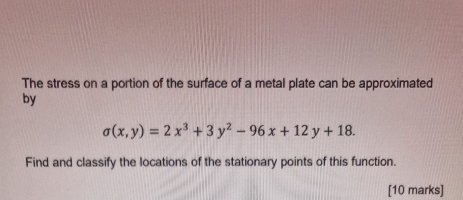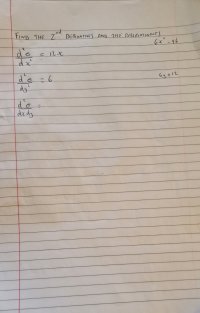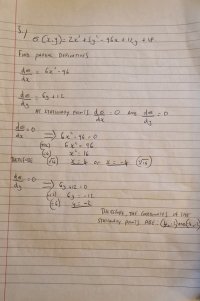You are using an out of date browser. It may not display this or other websites correctly.
You should upgrade or use an alternative browser.
You should upgrade or use an alternative browser.
Stationary points of a function
- Thread starter Bener123
- Start date
mmm4444bot
Super Moderator
- Joined
- Oct 6, 2005
- Messages
- 10,902
Hello Bener123. Please share your beginning thoughts/work, or explain the part(s) at issue. Thank you. ?I'm really struggling with it.
Posting Guidelines (Summary)
Welcome to our tutoring boards! :) This page summarizes the main points from our posting guidelines. As our name implies, we provide math help (primarily to students with homework). We do not generally post immediate answers or step-by-step solutions. We don't do your homework. We prefer to...
www.freemathhelp.com
[imath]\;[/imath]
BigBeachBanana
Senior Member
- Joined
- Nov 19, 2021
- Messages
- 2,181
We all love to help, but we need to know what you need help with.Would anyone like to help out on this?
Hi, I have added what I have so far. Just need to confirm if I'm right. I'm trying to figure out the second derivatives and the d^2omega/dxdy as you can see from the second page.
I need to know the min the max and saddle points and how to get there if that's doable.
I need to know the min the max and saddle points and how to get there if that's doable.
Attachments
Reference the first image posted on the first question ^We all love to help, but we need to know what you need help with.
BigBeachBanana
Senior Member
- Joined
- Nov 19, 2021
- Messages
- 2,181
I appreciate that, but it's the numerical part I am struggling with. I want to confirm I have the correct xx and yy (on the second page with the second derivatives) and if someone could please give me the numbers for dxdy, I will be able to figure out the rest.
BigBeachBanana
Senior Member
- Joined
- Nov 19, 2021
- Messages
- 2,181
I said they look good so far.I appreciate that, but it's the numerical part I am struggling with. I want to confirm I have the correct xx and yy (on the second page with the second derivatives) and if someone could please give me the numbers for dxdy, I will be able to figure out the rest.
[imath]f_{xy}=f_{yx}[/imath], You can either take the derivative of [imath]6x^2-96 [/imath] with respect to [imath]y[/imath] OR [imath]6y+12[/imath] with respect to [imath]x.[/imath]
I said they look good so far.
[imath]f_{xy}=f_{yx}[/imath], You can either take the derivative of [imath]6x^2-96 [/imath] with respect to [imath]y[/imath] OR [imath]6y+12[/imath] with respect to [imath]x.[/imath]
Understood. So if I took the derivative of X or Y, what answer do I get? Is it 6?I said they look good so far.
[imath]f_{xy}=f_{yx}[/imath], You can either take the derivative of [imath]6x^2-96 [/imath] with respect to [imath]y[/imath] OR [imath]6y+12[/imath] with respect to [imath]x.[/imath]
D
Deleted member 4993
Guest
NoUnderstood. So if I took the derivative of X or Y, what answer do I get? Is it 6?
Please share your work showing how you got 6.
I just went by the only thing the 2 equations have in common. Please can someone tell me what the fxy is.No
Please share your work showing how you got 6.
topsquark
Senior Member
- Joined
- Aug 27, 2012
- Messages
- 2,269
When you found [imath]f_x[/imath] you took the derivative as if y were a constant. When you found [imath]f_y[/imath] you took the derivative as if x were a constant. So how do you find [imath]f_{xy}[/imath]?I just went by the only thing the 2 equations have in common. Please can someone tell me what the fxy is.
-Dan
If I knew that, I wouldn't be posting it on here ?When you found [imath]f_x[/imath] you took the derivative as if y were a constant. When you found [imath]f_y[/imath] you took the derivative as if x were a constant. So how do you find [imath]f_{xy}[/imath]?
-Dan
BigBeachBanana
Senior Member
- Joined
- Nov 19, 2021
- Messages
- 2,181
I think you're just unfamiliar with the notation. It has nothing to do with what's in common. You know how to compute derivatives.If I knew that, I wouldn't be posting it on here ?
[imath]f_{xx}[/imath] means to take the derivative with respect to x twice.
[imath]f_{yy}[/imath] means to take the derivative with respect to y twice.
[imath]f_{xy}[/imath] means to take the derivative with respect to x first, then respect to y.
[imath]f_{yx}[/imath] means to take the derivative with respect to y first, then respect to x.
For example, [imath]f(x,y)=xy[/imath]
[imath]f_x=y[/imath]
[imath]f_{xy}=1[/imath]
[imath]f_{xx}=0[/imath]
[imath]f_y=x[/imath]
[imath]f_{yx}=1[/imath]
[imath]f_{yy}=0[/imath]
BigBeachBanana
Senior Member
- Joined
- Nov 19, 2021
- Messages
- 2,181
I told you how to get the answer earlier.So for the equations 6x^2-96 and 6y+12 what is the fxy?
If [imath]f_x=6x^2-96[/imath], then [imath]\red{f_{xy}=\frac{d}{dy}(6x^2-96)}[/imath].
Compute the derivative in red.
BigBeachBanana
Senior Member
- Joined
- Nov 19, 2021
- Messages
- 2,181
I know what the question is asking. With respect to y from x. I don't know how to do this bit. Please show me, answer it too so I can understand how to do it in the future.
When you differentiate with respect to y, treat all other variables that are not y as a constant, like number 2 for example. So in this case [imath], 6x^2-96[/imath] only contains x and no y. So you're basically differentiating a constant. What's the derivative of a constant?
Now, try the other way.
If [imath]f_y=6y+12[/imath], then [imath]\red{f_{yx}=\frac{d}{dx}(6y+12)}[/imath].
Compute the derivative in red.




